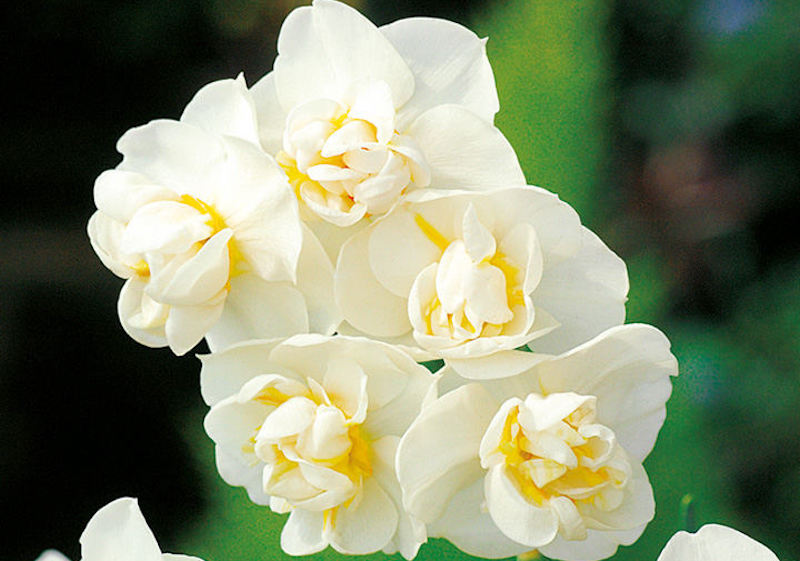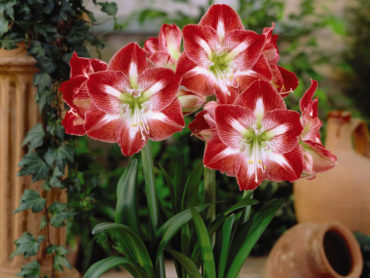Herald the beginning of warmer weather and longer days with a glorious display of spring-flowering bulbs. With a little planning, you can even enjoy flowers from January right through to the start of summer – a welcome splash of scent and colour when not much else is flowering.
Versatile and low-maintenance, bulbs will happily grow in containers, borders, through grass and under trees. Here’s everything you need to know to successfully grow all your favourite spring bulbs.
When should I plant spring-flowering bulbs?

Image: Daffodil (Double) Bulbs – Cheerfulness/Copyright: Floramedia
Plant your spring-flowering bulbs in autumn ready for flowers the following spring. Daffodils can be planted as early as August but tulips need low temperatures to flower properly, so are best planted no earlier than November. Ensure you plant your bulbs before the first frosts set in and read our article on when to plant spring bulbs for more information.
Where can I plant spring-flowering bulbs

Image: Shutterstock
Plant your spring-flowering bulbs in well-drained, humus-rich soil, in a sunny spot. Avoid waterlogged soil or areas of deep shade. When planting directly outdoors, group your bulbs together in groups of at least 6 to make a better display. Bulbs will thrive in well drained pots and containers too.
Woodland bulb types like snowdrops or Lamium maculatum ‘Beacon Silver’ do well in shady cooler spots under trees or planted into the lawn. Choose an area of the lawn where a clump of longer grass mixed with dying bulb foliage in summer won’t look out of place or hinder your lawn mowing.
Bulbs like Tulip sylvestris will self-seed and gradually spread wherever they’re planted, so make sure they have enough space to naturalise into drifts of stunning colour. Achieve a natural look when planting by gently rolling a handful of bulbs over the soil and planting them where they land.
How to plant spring bulbs

Image: Bulb Planting Tool from Suttons
As a rule, plant your bulbs at least twice as deep as their height, leaving about two bulb widths between each one. So, a bulb that is 5cm tall will do best planted at a depth of 10cm. The exception to this rule is tulip bulbs, which need to be planted at a depth of about 20cm. Planting at the correct depth will prevent your bulbs being damaged over winter by frost or pests.
Check your bulbs before planting, and only plant firm, healthy looking specimens that show no sign of rot or mould. You can use a bulb planting tool to get the correct depth and to make quick and easy work of getting your bulb into the soil. For even easier planting, use a bulb basket to support groups of bulbs in the soil and make it simple to lift and store after flowering.
Be sure to place your bulbs in the planting hole with the sprouting tip pointing upwards. Sometimes this can be hard to find, so if in doubt place your bulb on its side. Firm down the soil over your bulbs and water well. Avoid accidentally digging the bulbs up or spearing them with a fork by marking where they are using a label or short stick.
Try ‘lasagne’ planting in deep containers. Place the largest bulbs at the bottom, add a layer of compost and then the next sized bulbs. Repeat until you’ve placed the smallest bulbs at the top, covered with a layer of compost. Bulbs don’t like being in waterlogged soil so ensure your containers have plenty of grit incorporated into the medium and lots of drainage holes.
You may have also heard the term ‘in the green’ – meaning plants which have leaves, usually just after flowering is over. You can plant single flowered snowdrops and double snowdrops in this way in spring alongside English bluebells.
How to care for spring bulbs
After planting, water your bulbs in well and keep the soil moist rather than wet. Most bulbs are fairly low-maintenance at this point, and will only begin to peek up above the soil after winter has passed. You may need to protect your freshly planted containers with chicken wire or something similar to prevent your bulbs being excavated by mice or squirrels.
Once shooting tips appear above the soil in spring, feed container grown bulbs every few weeks with a liquid tomato feed. Stop feeding once flowering is over and the foliage has died back.
Let the foliage die down naturally after your bulbs finish flowering, to allow them to restock on energy for the following year. Lift tender spring bulbs in autumn to store in a frost free place over winter, and move pots of hardy bulbs to a more sheltered area. If you want to divide any large clumps of spring bulbs, now is the time to do it.
How to divide and propagate spring bulbs
It’s possible to collect seed from spring-flowering bulbs, however the seedlings produced from varieties (cultivars) may not produce flowers true to the look of the parent bulb. This is fine for creating simple flowering displays, however if a specific variety (cultivar) is desired then propagate your bulbs via division. Species bulbs will spread their seed, which can be collected, and propagate themselves naturally this way over the years.
Divide bulbs after flowering finishes, by carefully digging up a clump with a garden fork and gently untangling the main bulbs and smaller offsets. You can then plant the separated bulbs with leaves attached in containers. Offsets will develop and flower 2 to 3 years after potting up.
Alternatively, leave your bulbs to form larger clumps year after year. Daffodils will continue to perform well and provide a greater impact when flowering en masse.
How to force spring-flowering bulbs indoors for Christmas
Indoor bulbs like hyacinths and amaryllis can be potted up in autumn to flower at Christmas time. Plant your indoor bulbs in containers in the same way you would for growing outdoors, but keep the pots in a sheltered space like a shed or garage. Move your display into the house when sprouting tips appear above the soil surface.
Water your indoor bulbs displays regularly during growth and flowering, and keep them in a cool bright position, away from sources of dry heat like radiators.
After they’ve finished flowering, move your containers to a covered spot like a greenhouse and allow the foliage to die back. Store your bulbs in a cool dry place until autumn comes around again, and they can be planted up for new displays. For a step-by-step guide to forcing bulbs to flower indoors, read our article.
Which spring-flowering bulbs can I grow?

Image: Visions BV, Netherlands
Spring flowering bulbs are hugely versatile, and grow just as happily in containers on the balcony as in drifts in the border. However, some bulbs suit certain conditions better than others.
For indoor displays, choose scented bulbs like Narcissus papyraceus or hyacinth ‘Pink Pearl’ to fill the house with scent. Tender bulbs like amaryllis that won’t tolerate frost are a good choice for indoor bulb displays too.
Outdoors, plant up lawns and tree bases with hardy native snowdrops, crocus and cyclamen for early flowering. These bulbs also look great in a naturalised woodland scheme. Daffodils are classic spring flowers that come in a huge range of scents and forms. Plant highly scented varieties near paths and entrances where they can be fully appreciated. Try a double variety for larger flower heads or a new pink ‘Passionale’ for something a bit different. Alternatively, go traditional with a simple yellow trumpet like ‘Cornish Trelawney Gold’. Pair your daffodils with sophisticated tulips to fill your outdoor space with bright colour.
We hope you’ve found our guide to growing spring flowering bulbs helpful. Check out all our growing guides for more tips and advice for growing flowers and vegetables. Share your spring displays with us via our social channels!
Lead image: Bumper Spring Bulbs Collection from Suttons
Last Updated on June 12, 2025 by Suttons Horticultural Team








